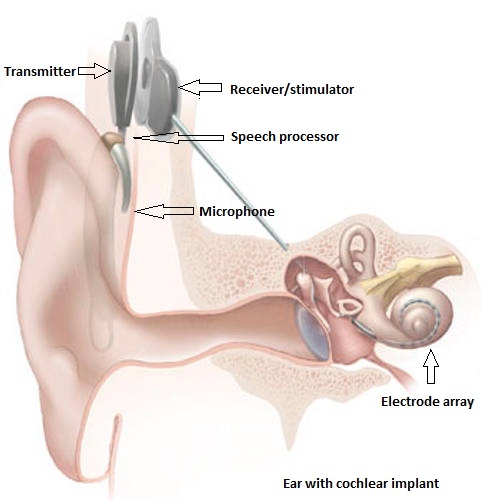Supporting Students with a Cochlear Implant

What is a Cochlear Implant?
A cochlear implant is a small electronic device that can help users experience sound. Cochlear implants are designed for people (children and adults) with a profound to severe sensor neural hearing loss, which occurs when the parts of the inner ear don’t work properly. The implant consists of an external portion that sits behind the ear and a second portion that is surgically placed under the skin (see figure).
An implant has the following parts:
- A microphone, which picks up sound from the environment.
- A speech processor, which selects and arranges sounds picked up by the microphone
- A transmitter and receiver/stimulator, which receive signals from the speech processor and convert them into electric impulses.
- An electrode array, which is a group of electrodes that collects the impulses from the stimulator and sends them to different regions of the auditory nerve.
Note: An implant does not restore normal hearing. Instead, it can give a deaf person a useful representation of sounds in the environment and help him or her to understand speech.
FAQ
How does a cochlear implant work?
A cochlear implant is very different from a hearing aid. Hearing aids amplify sounds so they may be detected by damaged ears. Cochlear implants bypass damaged portions of the ear and directly stimulate the auditory nerve. Signals generated by the implant are sent by way of the auditory nerve to the brain, which recognizes the signals as sound. Hearing through a cochlear implant is different from normal hearing and takes time to learn or relearn. However, it allows many people to recognize warning signals, understand other sounds in the environment, and enjoy a conversation in person or by telephone.
Does a cochlear implant make the person hearing?
No, the cochlear implant does not make deaf people hearing. Rather, it is a tool to give you access to more sounds.
Is an Implant better than Hearing Aids?
It is difficult to predict how each person will do with a cochlear implant, because everyone is different. During the cochlear implant evaluation, the audiologist and/or cochlear implant surgeon will discuss realistic expectations.
How do I support a student with a cochlear implant?
There is no quick fix to supporting students with cochlear implants; each student will need different support depending on the level of benefit the cochlear implant gives them. The type and amount of support needs to be evaluated on a case by case basis.
What is a hearing loop?
Even with hearing aids or cochlear implants, it can be hard to hear properly under noisy conditions or over distance such as a lecture theatre. An induction loop system can help by transmitting an audio signal directly to the listener from a microphone or amplifier. This both minimises the background noise and improves the clarity of the incoming voice. Loop systems don’t require the listener to wear a separate receiver device. Instead, the audio is transmitted from the induction loop into a telecoil inside their hearing aids or cochlear implant speech processor.
What is an FM system?
A wireless FM system (either RF or IR) sends speech signals to the listener, who wears a tiny FM receiver behind the ear, or through a headset. FM systems help to better understand speech by cutting out distracting background noise. It works in conjunction with the hearing aids or cochlear implant to deliver the sounds directly to the receiver from a microphone that the speaker wears. The limitation of this is that the student can only hear the lecturer and will miss out on a significant amount of classroom discussion.
Some Tips
Consult with an audiologist or specialist to see which assistive listening devices are suitable or available to assist your student in class or lectures.
Meet with the student and specialists (audiologist) to work out how to best support the student, the student should be able to advise you as to what has and hasn’t worked in the past.
If available, use a live captioning system, either stenographer sitting next to a student or a remote captioning service and provide a transcript of the lecture.
If the students signs use an Interpreter in conjunction with a note taker, the student will get far more information from the interpreter than they will by trying to follow the lecturer and take notes themselves.
In lectures understand that listening, watching, lip-reading and trying to fill in the blanks can be exhausting for students with the cochlear and they will not receive “all” the information so try to provide additional materials where appropriate such as lecture notes.
Structure tutorials so that the interactive part of the lecture has a controlled question and answer time (one question at a time model) the lecturer may need to repeat the answer/s so that the student can follow better.
Note these are only suggestions you will need to discuss preferred option for support with the student, an audiologist or hearing technology professional to establish the resources you have and what is needed by the student.

